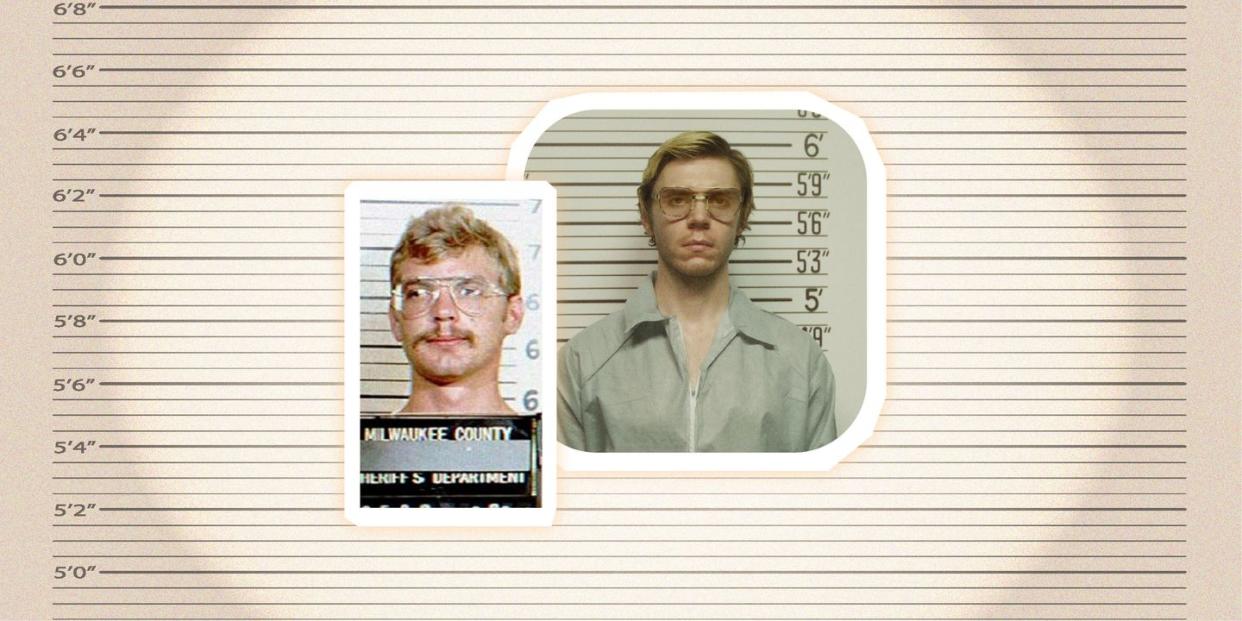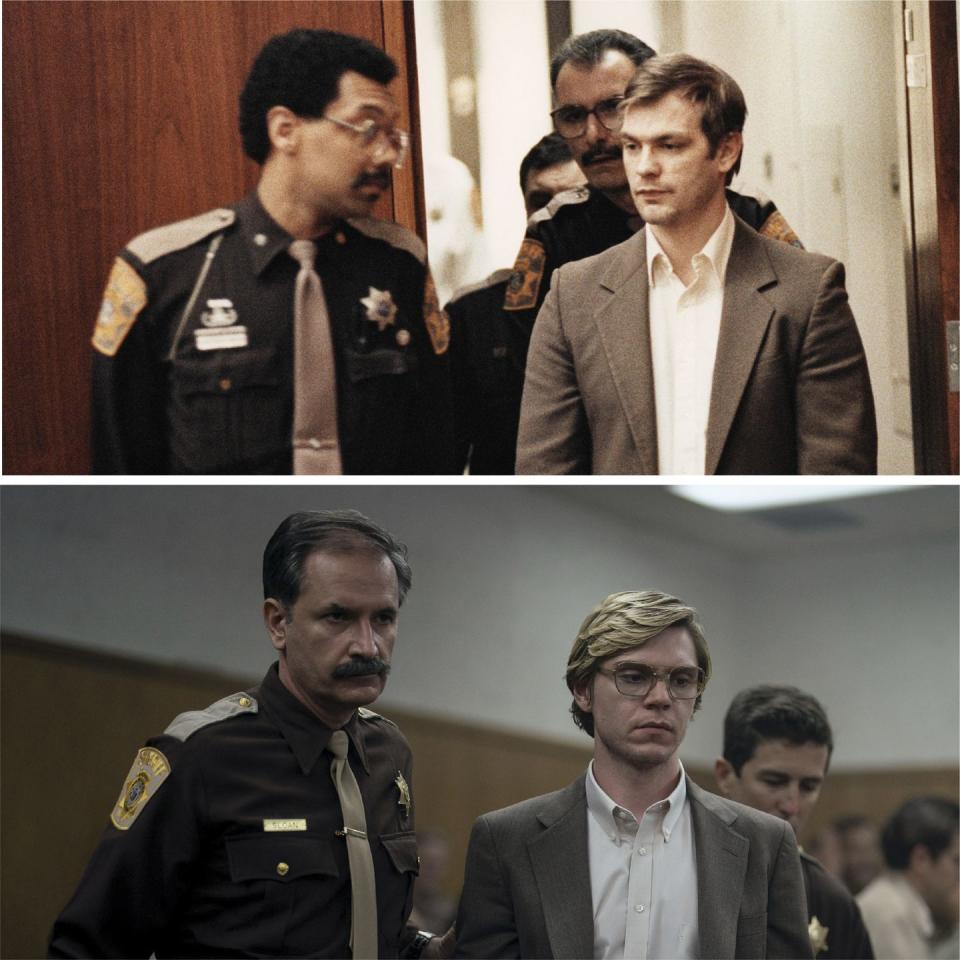Fact Or Fiction: How Much of Netflix's Dahmer Show Monster Is REALLY True?

"Hearst Magazines and Yahoo may earn commission or revenue on some items through the links below."
Content warning: This article contains discussion of murder and sexual assault some may find upsetting. Reader discretion is advised.
Ryan Murphy's DAHMER - Monster: The Jeffrey Dahmer Story debuted at No.1 on Netflix with 196 million hours viewed. Evan Peters stars in the fictionalized retelling of the serial killer who was notorious for committing horrific killings that took the lives of 17 boys and men between 1978 and 1991. The 10-episode series showcased unbelievable negligence by police officials and gruesome crimes that left many viewers with questions about what was the truth about Dahmer's crime spree and subsequent arrest, and fictional aspects were dramatized for entertainment.
Details have since been uncovered about what happened to the apartment building where many of the crimes occurred, recent updates about Dahmer's father, Lionel, who currently lives in Ohio, and the death of the killer's biological mother, Joyce, who passed away from breast cancer in 2000. Other true crime-inspired questions about Dahmer's brother, David, and a timeline of his crimes were also confirmed as well. Other important facts, including questions about Dahmer's run-ins with his neighbor Glenda Cleveland, were left up for debate after tuning into the series. Ahead, discover the true facts and what's mere fiction from Netflix's DAHMER- Monster: The Jeffrey Dahmer Story.
Glenda Cleveland didn't live in the Oxford Apartments, and she never met Dahmer
Niecy Nash's character Glenda Cleveland plays a significant role in Dahmer's arrest. In the series, Cleveland is Dahmer's neighbor, and they have frequent interactions that lead to multiple police complaints. In real life, the pair never met, and Cleveland never lived inside Dahmer's building. She actually lived in the neighboring building.
She did, however, make multiple attempts to alert local police and the FBI about Dahmer's behavior. In the series, Cleveland's daughter, Sandra Smith, and niece, Nicole Childress, saw a disoriented 14-year-old Konerak Sinthasomphone escaping from an alley near Dahmer's apartment on May 27, 1991. Cleveland contacted the police, who arrived and ultimately returned the teen back into Dahmer's custody before he was subsequently killed. Dahmer told the police that Sinthasomphone, who was visibly impaired, was his 19-year-old boyfriend and that he was drunk.
Dahmer fed sandwiches to his neighbor Pamela Bass
Pamela Bass is the woman who lived next door to Dahmer. She was relatively fond of him and didn't have many suspicions about what he was doing. She was not included in the Netflix limited series. After Dahmer's arrest, Bass went on the record confirming that Dahmer was "friendly and sharing." She even confirmed that he had fed her sandwiches. Once the brutal nature of Dahmer's crimes were confirmed, Bass expressed her fear that they may have contained human flesh. "I have probably eaten someone's body parts," she said in The Jeffrey Dahmer Files movie.
Dahmer did not drink bags of blood while working at the Milwaukee Blood Plasma Center
Episode four followed Dahmer after he got a job as a phlebotomist at the Milwaukee Blood Plasma Center. In a disturbing twist, he brought home a bag of blood to drink. According to Dahmer's reports to police officials in real life, he tried to drink a vial of blood on the roof of the center, but he wound up spitting it out.
Police Officers John Balcerzak and Joseph Gabrish did not receive "Officer of the Year"
Officers John Balcerzak and Joseph Gabrish received an officer of the year commendation in episode nine of the limited series. That never happened in real life. Both officers, who were suspended after Dahmer's arrest, were reinstated in 1994, but they were never recognized as officer of the year. Balcerzak eventually became the president of the Milwaukee police officer's union.
Dahmer did not wear glasses during his trial
The accused killer did not wear the trademark aviator glasses he became recognized for during his trial. During an interview with Inside Edition, Dahmer said, "I felt uncomfortable looking anyone in the face, I didn't want to see anyone's face clearly, it helped me disassociate myself from what was happening."

Dahmer did often show victims The Exorcist III movie
During his interview with Inside Edition, Dahmer confirmed that he showed his victims The Exorcist III movie. "I felt so hopelessly evil and perverted that I actually derived a sort of pleasure from watching that tape. Dahmer said that he didn't like feeling evil and that though he'd try to overcome those thoughts and urges to kill, he eventually gave in.
Dahmer did say to Tracy Edwards, ‘I want to hear your heart because I’m going to eat it’
During his testimony, Tracy Edwards confirmed that Dhamer delivered the sinister warning before he ultimately escaped Dahmer's home alive.
Jeffrey Dahmer was pulled over by police when he had human remains in his car
According to Dahmer's testimony, which was obtained by the New York Times, he was pulled over by police officials after he killed his first victim, 18-year-old Steven Hicks, in 1978. He convinced the officers to let him go despite swerving while driving at 3:00 a.m with garbage bags of Hick's remains in his backseat.
Dahmer was previously arrested
He received a $50 fine for indecent exposure at the Wisconsin State Fair. He was kicked out of a bathhouse, where he was accused of drugging two patrons. The manager of the bathhouse testified at his trial.
According to Showbiz Cheatsheet, Dahmer was charged with sexual assault and enticing Somsack Sinthasomphone in September 1988. He received one year in prison with work release and five years probation. Somsack was the older brother of Dahmer victim Konerak.
Dahmer's father, Lionel, asked for a judge to intervene after Dahmer was convicted for sexually assaulting the brother of one of his future victims
Dahmer read a letter he wrote to Judge William Gardner in 1990 pleading for some sort of help or intervention before his son was released in Investigation Discovery's 2020 series Jeffrey Dahmer: Mind of a Monster. "I have reservations regarding Jeff's chances when he hits the streets. I have experienced an extremely frustrating time trying to urge initiation of some type of treatment," he recounted. "I sincerely hope that you might intervene in some way to help my son, who I love very much and for whom I want a better life. I do feel, though, that this may be our last chance to initiate something lasting and that you can hold the key."
Dahmer harassed his victim's family members
In episode six, Dahmer taunted the family members of his victims. As depicted, he called the families on the phone and told them to stop looking for their missing loved ones.
Glenda Cleveland repeatedly followed up with Milwaukee police about her suspicions
As depicted throughout the limited series, Cleveland indeed contacted the Milwaukee police department about her concerns regarding Dahmer after seeing a newspaper article highlighting the disappearance of Sinthasomphone.
When her calls to local authorities were unanswered, she contacted the FBI and was informed that it did not have jurisdiction. Despite Cleveland saying she called for "months and months," Dahmer was arrested in real life seven weeks after.
Cleveland met with Jesse Jackson following Dahmer's arrest
Civil rights activist Jesse Jackson hosted a rally in Milwaukee after Dahmer's arrest. Along with meeting with the city's mayor, he also met with Cleveland.
Tenants in the Oxford Apartments complained about the smell and noises
While Cleveland may not have been one of Dahmer's neighbors, someone who actually lived in his building complained about the scent coming from his apartment. During his testimony, Sopa Princewell confirmed the complaints.
You Might Also Like

